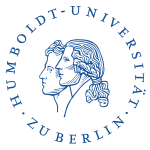Humboldt-University
| Humboldt-Universität zu Berlin | |

|
|
| Motto | Universitas litterarum (Latin) |
|---|---|
|
Motto in English
|
The Entity of Sciences |
| Type | Public |
| Established | 15 October 1811 |
| Budget | € 397.8 million |
| President | Sabine Kunst |
|
Academic staff
|
2,403 |
|
Administrative staff
|
1,516 |
| Students | 32,553 |
| Undergraduates | 18,712 |
| Postgraduates | 10,881 |
| 2,951 | |
| Location | Berlin, Germany |
| Campus | Urban and Suburban |
| Nobel Laureates | 40 |
| Colors | Blue and white |
| Affiliations |
German Universities Excellence Initiative UNICA U15 Atomium Culture EUA |
| Website | www.hu-berlin.de |
| University rankings | |
|---|---|
| Global | |
| Times | =57 |
| QS | =121 |
The Humboldt University of Berlin (German: Humboldt-Universität zu Berlin, abbreviated HU Berlin) is one of Berlin's oldest universities, founded on 15 October 1811 as the University of Berlin (Berliner Universität) by Frederick William III of Prussia, on the initiative of the liberal Prussian educational reformer and linguist Wilhelm von Humboldt. The university is known worldwide for pioneering the Humboldtian model of higher education, which has strongly influenced other European and Western universities, and the university has been widely called "the mother of all modern universities." The university has been associated with 40 Nobel Prize winners and is considered one of the best universities in Europe as well as one of the most prestigious universities in the world for arts and humanities. It was widely regarded as the world's preeminent university for the natural sciences during the 19th and early 20th century, and is linked to major breakthroughs in physics and other sciences by its professors such as Albert Einstein.
From 1828 until its closure in 1945 it was known as the Frederick William University (Friedrich-Wilhelms-Universität) and also (unofficially) as the Universität unter den Linden after its location in the former palace of Prince Henry of Prussia which his brother, King Frederick II, had built for him between 1748 and 1753 on the avenue Unter den Linden.
During the Cold War, the old university buildings were located in East Berlin. The university reopened in 1946, but due to communist repression, including the Soviet execution of liberal and social democrat students who fought for democracy, the Free University of Berlin was established as a de facto western successor in West Berlin in 1948, with support from the United States, and retaining traditions and faculty members of the old Frederick William University; the name of the Free University refers to West Berlin's status as part of the Western "free world," in contrast to the "unfree" Communist world in general and the "unfree" communist-controlled university in East Berlin in particular. In 1949, the university in East Berlin was renamed Humboldt University in honour of both its original founder Wilhelm and his brother, geographer Alexander von Humboldt. Due to the uncontroversial nature of this name and because it had been chosen by the university itself as an act of resistance against naming the university after a communist leader, it was retained after the fall of communism. However the fall of the communist regime led to a total reform of the university from 1990, including the dissolution of many departments regarded as politicized, and the termination of all employees, who were largely replaced by western academics untainted by communism when the positions were readvertised. The decommunization was carried out more vigorously at the Humboldt University than any other university in the former GDR, and as a result, the Humboldt University after German reunification is firmly rooted in the West German academic tradition with little continuity from the communist-era university.
...
Wikipedia
